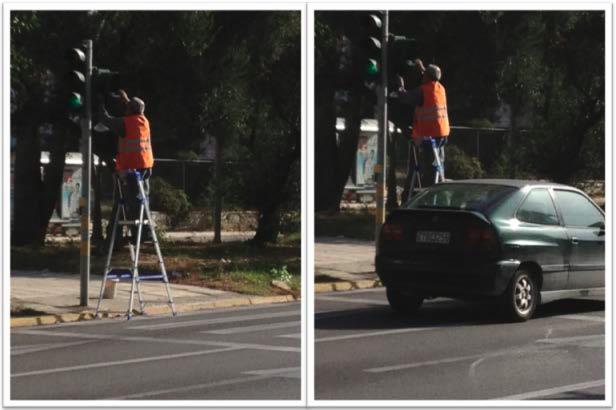Spot The Safety Violation: Working by Roads Is Dangerous Business
What measures should be in place to better protect this worker than a mere high visibility vest’

Often, the location where work is performed is what poses the greatest safety risk to workers. For example, work done on or near active roadways is hazardous because of the passing traffic. So it’s important to have adequate safety measures in place to protect workers while they’re working by or on roads and highways.
In this picture from the US Naval Safety Center, a worker is standing on a ladder while changing a light bulb in a traffic sign. The good news is that he’s wearing a high visibility vest. The bad news is that there don’t appear to be any other safety measures in place to protect him.
For example, two of the feet of his ladder are in the street. But there are no cones or warning signs in place to alert passing drivers to his presence. And as is apparent in the second picture, cars were passing quite close to him.
The worker in the picture was fortunate that he didn’t get injured or worse. But others in similar positions haven’t been so lucky.
Example: A Toronto worker was in a cherry picker changing a street light bulb when his vehicle was hit by a passing truck. He was knocked out of the bucket and suffered non-life-threatening injuries.
TAKE 4 STEPS
You need to ensure that workers are safe any time they’re working on or near active roadways. One effective way to do so is with a traffic control plan. To implement such a plan, take these four steps:
Step #1. Assess the location of the work. Assess all key aspects of the location where the work will be done, including the type of road, approaches to the work area, speed limit, traffic volume, shoulders, weather conditions and any site hazards.
Step #2. Assess the risks of the work. Consider any risks of the work itself, such as where it’ll be done (on the road, on the shoulder, etc.), whether the site is stationary or moving, the type of work, the equipment to be used and the hours of work.
Step #3. Develop a plan. Based on the hazards identified in the above assessments, develop a traffic control plan that spells out the safety measures you’ll use to protect workers from these hazards. This form can help you develop an appropriate traffic control plan.
Step #4. Train workers. Train all workers who’ll be doing the work near the road as well as those acting as traffic control persons or ‘flaggers’ on the traffic control plan. And make sure to keep a copy of the plan at the work location at all times.
Remember: Even something as simple as changing a light bulb in a traffic sign can put workers at risk.